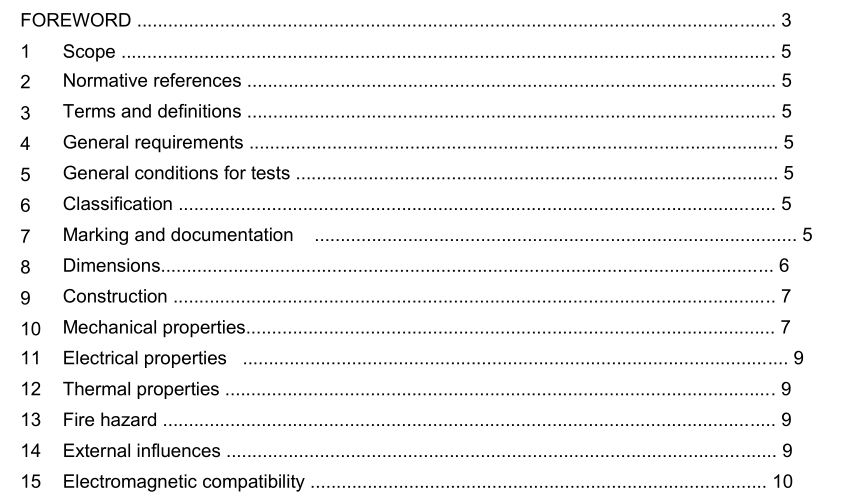IEC 61386-21-2021 pdf Conduit systems for cable management – Part 21: Particular requirements – Rigid conduit systems

7.1.101 The conduit shall be marked in accordance with 7.1 along its entire length at regular intervals of preferably 1 m but not longer than 3 m and each length shall be marked at least once. Compliance is checked by inspection. 7.1.102 The manufacturer shall document, for the conduit system, the minimum inside diameter and the classification in accordance with Clause 6. Compliance is checked by inspection of the documentation. 7.1.103 The manufacturer shall declare whether the conduit is bendable and provide all information, instructions and, if necessary, bending aids for proper and safe bending of the conduit. Compliance is checked by inspection and by the tests specified in 10.4 and 10.6. 8 Dimensions Replacement: 8.1 Threads and outside diameters shall comply with IEC 60423. Compliance is checked by means of the gauges specified in IEC 60423. 8.2 Threadable conduits and threadable conduit fittings, except terminating conduit fittings, shall comply with Table 101. Non-threadable conduit fittings, except fittings which are part of a conduit system declaring tensile strength, shall comply with Table 102. The minimum inside diameter of the conduit system shall be as declared by the manufacturer. Compliance is checked by measurement.
10.4.101.2 Samples having a length equal to 30 times the nominal diameter, are bent so that when released, they have an angle of (90 ± 5)°, so that the inside radius of the bend is equal to six times the nominal diameter. 10.4.101.3 For conduits with welded seams, six samples are tested, three with the seam on the outside of the bend, three with the seam on the side. 10.4.101.4 After the test: – the basic material of the conduits and the protective coating of the conduits shall show no cracks visible to normal or corrected vision without magnification; – seams, if any, shall not have opened; – the section of the conduit shall not have distorted unduly. The distortion of the section is checked as follows: When the bent conduit is held in such a position that the straight portions are at an angle of approximately 45° to the vertical, one end of the sample pointing upwards and the other downwards, it shall be possible to pass the appropriate gauge as shown in Figure 102 through the sample under its own weight and without any initial speed. 10.4.102 Non-metallic conduits 10.4.102.1 Conduit sizes 16, 20 and 25 are subjected to a bending test by means of the apparatus shown in Figure 103. The length of the sample is 500 mm ± 10 mm. Testing of other sizes is in accordance with the manufacturer’s instructions. 10.4.102.2 A bending aid, in the form of a coiled spring of square section metal wire, without burrs and having an overall diameter between 0,7 mm and 1,0 mm less than the specified minimum inside diameter of the conduit, or a bending aid recommended by the manufacturer, is inserted into each sample before bending.
- Previous:IEC 61386-23-2021 pdf Conduit systems for cable management – Part 23: Particular requirements – Flexible conduit systems
- Next:IEC 61215-1-2-2021 pdf Terrestrial photovoltaic (PV) modules – Design qualification and type approval – Part 1-2: Special requirements for testing of thin-film Cadmium Telluride (CdTe) based photovoltaic (PV) modules
- ISO IEC 27050-4-2021 pdf Information technology — Electronic discovery — Part 4: Technical readiness
- ISO IEC 27036-1-2021 pdf Cybersecurity — Supplier relationships — Part 1: Overview and concepts
- ISO IEC 27013-2021 pdf Information security, cybersecurity and privacy protection — Guidance on the integrated implementation of ISO/IEC 27001 and ISO/IEC 20000-1
- ISO IEC 26580-2021 pdf Software and systems engineering — Methods and tools for the feature- based approach to software and systems product line engineering
- ISO IEC 24735-2021 pdf Information technology — Office equipment — Method for measuring digital copying productivity
- ISO IEC 24711-2021 pdf Information technology — Office equipment — Method for the determination of ink cartridge yield for colour inkjet printers and multi- function devices that contain printer components
- ISO IEC 23544-2021 pdf Information Technology — Data centres — Application Platform Energy Effectiveness (APEE)
- ISO IEC 23510-2021 pdf Information technology — 3D printing and scanning — Framework for an Additive Manufacturing Service Platform (AMSP)
- ISO IEC 23127-1-2021 pdf Information technology — Learning, education, and training — Metadata for facilitators of online learning — Part 1: Framework
- ISO IEC 23126-2021 pdf Information technology for learning, education and training — Ubiquitous learning resource organization and description framework
- IEC 60034-9-2021 pdf Rotating electrical machines – Part 9: Noise limits
- ISO IEC 18328-2-2021 pdf Identification cards — ICC-managed devices — Part 2: Physical characteristics and test methods for cards with devices
- IEC 63171-2-2021 pdf Connectors for electrical and electronic equipment – Part 2: Detail specification for 2-way, shielded or unshielded, free and fixed connectors: mechanical mating information, pin assignment and additional requirements for type 2
- IEC 61453-2007 pdf Nuclear instrumentation – Scintillation gamma ray detector systems for the assay of radionuclides – Calibration and routine tests
- IEC TR 63042-303-2021 pdf UHV AC transmission systems – Part 303: Guideline for the measurement of UHV AC transmission line power frequency parameters
- BS ISO IEC 15420-2009 pdf Information technology一 Automatic identification and data capture techniques EAN/UPC bar code symbology specification
- BS IEC 60860-2014 pdf Radiation protection instrumentation一 Warning equipment for criticality accidents
- BS ISO IEC 19762.5-2008 pdf Information technology一 Automatic identification and data capture (AIDC) techniques – Harmonized vocabulary Part 5: Locating systems
- ISO IEC 24735-2021 pdf Information technology — Office equipment — Method for measuring digital copying productivity
- ISO IEC 24711-2021 pdf Information technology — Office equipment — Method for the determination of ink cartridge yield for colour inkjet printers and multi- function devices that contain printer components